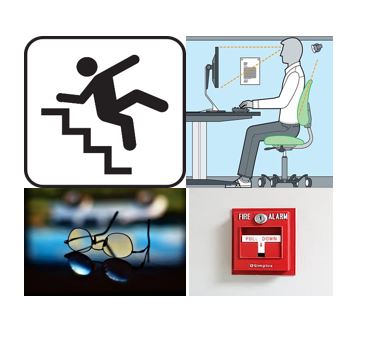
Here are 25 step to reduce injury in an office setting:
Falls. Slips, trips and falls are the most common type of office injury according to the Bureau of Labor Statistics.
• Stay clutter free. Items piled in walkways create a tripping hazard. Store things in the proper location and put away supplies promptly when received. Don’t stretch electrical cords across walkways or under rugs. Use a commercially available cord saver.
• Step on up. Never stand on chairs, especially rolling office chairs. Use a step stool or step ladder that is in good condition. Step stools or ladders must be fully opened and placed on a level, firm surface. Never stand on steps higher than the designated ‘safe standing’ height.
• Maintain a clear line of vision. Avoid collisions when navigating blind corners. Stay alert when walking down hallways; don’t be distracted by texting, reading, or other activity.
• Get a grip. Tile can be slippery when wet. “Walk off” moisture on the entrance mat when entering buildings with feet wet from rain or snow.
• Use handrails. When going up/down stairs use handrails. Don’t carry heavy/awkward loads.
• Wear sturdy, supportive, slip-resistant shoes.
Struck/caught by. Another major type of injury in an office setting.
• Shut the drawer. It is easy to forget/not notice a desk or file cabinet drawer is open and walk into it. Shut drawers immediately after inserting/removing items. Avoid file cabinets that allow more than one drawer to be open at a time, or secure them to prevent tipping.
• Safe stacking. Stacks of equipment or heavy items can cause serious injury if they fall/are knocked over. Store heavy objects close to the floor. Be aware of shelving capacity and do not exceed the recommended load.
Ergonomic Injuries. If the majority of the day is spent at a desk and working on a computer strain can result.
Here are items to consider: Use adjustable equipment/know how to adjust your desktop items for optimal positioning; Keep your feet on the floor and maintain good posture; Use document holders if type from hard copy frequently; Correctly position your mouse.
Guidelines and recommendations are available through the Occupational Safety and Health Administration (OSHA) and the National Institute for Safety and Health (NIOSH). NIOSH provides a Computer Workstation Ergonomic: Self-Assessment Checklist which includes questions and suggested actions if an adjustment is needed.
At UNL more in-depth ergonomic guidance is available through the Office of Institutional Equity and Compliance.
Vision problems. Avoid dry eyes and eyestrain.
• Dim the lights or use task lamps. Fluorescent lights are often too bright for optimal vision.
• Correctly position monitors. Computer monitors should be slightly below eye level and 20-26 inched from the eyes.
• Minimize screen glare. Avoid positioning monitors opposite open windows or close blinds/shades.
• Wear the right glasses. Let your eye doctor know if you spend a large portion of the day working on the computer.
• Increase the font size on the computer. Small font sizes can strain both your vision and your neck.
• Take a break. OSHA recommends that workers give their eyes a 10-minute break for every hour on the computer by switching to a task that requires your eyes to focus at a further range.
Fire safety. Routine inspections around the office can help reduce the likelihood of fire.
• Maintain cords in good repair. Damaged and ungrounded power cords pose a serious fire hazard. Remove any from service with frayed cords/exposed wires. Make sure cords are not overloading circuits. Do not use extension cords as permanent wiring.
• Do not use space heaters.
• Never block fire sprinkler heads. Never place anything higher than 18 inches below sprinkler heads to allow a full range of coverage.
• Do not block escape routes or prop open fire doors. Never store items in an emergency exit route.
• Do not use “power strips” to energize high amperage devices (e.g., refrigerators, coffee pots, microwaves, etc.).
• Avoid excessive accumulation of ordinary combustibles (e.g., paper, cardboard, etc.).